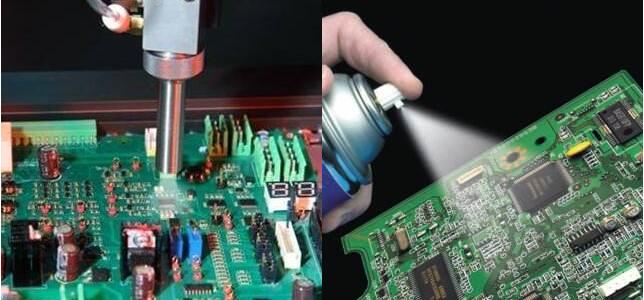About us
FASTPCBA Co.,Ltd
-
 Building 1, Senyang Electronic Technology Park, Guangming High-tech Park, Yutang Street, Guangming District, Shenzhen City.
Building 1, Senyang Electronic Technology Park, Guangming High-tech Park, Yutang Street, Guangming District, Shenzhen City.
-
 F:86-13418481618
F:86-13418481618
-
 pcba13@fastpcba.cn
pcba13@fastpcba.cn
 date:2019-07-22 15:21:37
date:2019-07-22 15:21:37
Prototype pcb assembly three anti-paint spraying technics and precautions
Prototype pcb assembly three anti-paint has superior insulation, anti-moisture, anti-leakage, anti-shock, anti-dust, anti-corrosion, anti-aging, anti-mold, anti-part loose and insulation and corona resistance, which can extend PCBA storage time. Among them, the spraying method is the most commonly used coating method in the industry.

First,prototype pcb assembly three anti-paint spraying technics process
1.The tools needed
Prototype pcb assembly three anti-paint, paint box, rubber gloves, mask or gas mask, brush, tape, tweezers, ventilation equipment, drying rack, oven.
2.Spraying steps
Brush A side → dry surface → brush B side → room temperature curing
3. Coating requirements
(1) Clean and bake the board to remove moisture. The dust, moisture and oil on the surface of the object to be coated must be removed firstly so that it can fully exert its protective effect. Thorough cleaning ensures that corrosive residues are completely removed and the three anti-paints adhere well to the surface of the board. Baking conditions: 60 ° C, 10-20 minutes, after the removal in the oven, the hot coating effect is better;
(2) When prototype pcb assembly applying three anti-paints by brushing, the brushing area should be larger than the area occupied by the devices to ensure that all the devices and pads are covered;
(3) When the prototype pcb assembly three anti-paints are painted, the circuit board should be placed as flat as possible. There should be no drop after brushing. The brush should be flat and no exposed parts. It should be between 0.1-0.3mm.
(4) Before brushing and spraying the three anti-paints, ensure that the diluted three anti-paint is thoroughly stirred and placed for 2 hours before brushing or spraying. Using high quality natural fiber brush and gently apply a dip coating at room temperature. If using machinery, the viscosity of the coating should be measured (using viscosity agent or flow cup) and the viscosity can be adjusted with a diluent.
(5) The circuit board assemblies should be vertically immersed in the paint stain. Do not immerse the connector, unless carefully covered, the board should be immersed for 1 minute until the bubble disappears, then slowly take out.Evenly film layer is formed on the board surface. Most of the paint residue should flow back from the board to the dipper. TFCF has different coating requirements. The circuit board or assemblies should not be immersed too fast to avoid excessive air bubbles.
(6) When using it again after dip coating, if there is skin on the surface, remove the epidermis and continue to use it.
(7) After brushing, the circuit board is placed flat on the rack to prepare for curing, and the heating method is required to accelerate the curing of the coating. If the surface of the coating is uneven or contains air bubbles, it should be allowed to stand at room temperature for more time to solidify in a high temperature furnace to allow the solvent to flash out.
Second, the matters needing attention
1. During the spraying process of prototype pcb assembly, some components can not be sprayed, such as: high power with heat sink or radiator components, power resistors, power diodes, cement resistors, dial switches, adjustable resistors, buzzers, Battery holder, fuse holder (tube), IC holder, tact switch, etc.
2. It is forbidden to return the remaining three anti-paints to the original storage container, and keep them separately.
3. If the working room or storage room is not opened for a long time (more than 12 hours), it should be ventilated for 15 minutes before entering.
4.Accidentally splashed into the glasses should immediately open the upper and lower eyelids, rinse with running water or saline, and then seek medical treatment.
PCBA three anti-paint spraying method is a relatively common technics, which can be divided into manual coating and machine coating.
 Building 1, Senyang Electronic Technology Park, Guangming High-tech Park, Yutang Street, Guangming District, Shenzhen City.
Building 1, Senyang Electronic Technology Park, Guangming High-tech Park, Yutang Street, Guangming District, Shenzhen City.
 F:86-13418481618
F:86-13418481618
 pcba13@fastpcba.cn
pcba13@fastpcba.cn